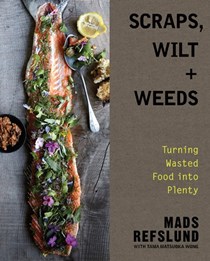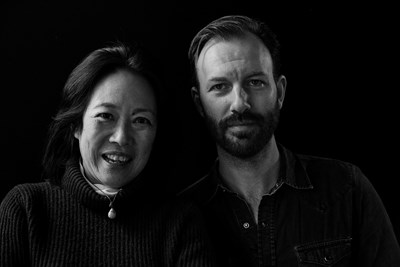Scraps, Wilt + Weeds
March 23, 2017 by Jenny Scraps, Wilt & Weeds:
Turning Wasted Food into Plenty by Mads Refslund and Tama
Matsuoka Wong embraces the no-scrap-left- behind culinary
trend with recipes that will surprise and excite you.
Scraps, Wilt & Weeds:
Turning Wasted Food into Plenty by Mads Refslund and Tama
Matsuoka Wong embraces the no-scrap-left- behind culinary
trend with recipes that will surprise and excite you.
Refslund, the talented chef and co-founder of NOMA along with
Wong, author of Foraged Flavor, provide advice on how to throw
away less – from preserving food to creatively using parts of
ingredients that people commonly overlook. The authors give a whole
new meaning to whole food cooking. For example Skillet-Roasted
Cauliflower Cores & Leaves with Brie, Broccoli Stems with Lardo
& Fresh Coriander Seeds, and Flat Bread and Day-Old Bread
Porridge will have us envisioning new ways to throw out far
less.
For a book on trash cooking, it certainly is beautiful
with photographs of dishes that would rival any fine dining
experience. What is most appealing is the permission to use less
than perfect ingredients for instance – ugly garlic – shriveled
is fine. As cooks we are often told to use the finest most
perfect ingredients and I love being told that imperfect is not
only acceptable but encouraged. The advice on how to forage and
find uses for those riches found in nature is very interesting. In
a world where so many people go hungry, this is a book and
lifestyle more of us need to embrace.
The authors were gracious enough to answer a few questions about
their new cookbook and the trashing cooking movement. Please be
sure to head to our contest page to enter our giveaway for one
of three copies of this cookbook open to our members in the US and
Canada.
 Q: First, let me thank you for
allowing me to ask a few questions about your new book for our
members. Scraps, Wilt + Weeds Turning Wasted Food into
Plenty is a gorgeous book. How did the idea come about to do a
cookbook devoted to Trash Cooking?
Q: First, let me thank you for
allowing me to ask a few questions about your new book for our
members. Scraps, Wilt + Weeds Turning Wasted Food into
Plenty is a gorgeous book. How did the idea come about to do a
cookbook devoted to Trash Cooking?
A: Thank you for your interest! The book stemmed from a common philosophy that we share about discovering the deliciousness of underappreciated “wasted” foods, whether a wild weed or an unused part of a plant or fish. It’s at the core of how we each live in our separate domains: Mads as an innovative chef with respect for the whole produce as found in nature and Tama in making a living gleaning the unwanted weeds that people would ordinarily stomp on.
We’ve been working together now for years and it came up in a conversation and Mads said “oh yah Trash Cooking” let’s do it!
Q: I love the concept of utilizing normally wasted food but I am a tad put off with the term Trash Cooking – are you finding any resistance with that terminology or are people embracing it like the Dumpster Diving movement?
A: Yes well there was an ongoing debate about the title of the book for that very reason. People have different reactions and we don’t want them to be put off by choice of words.
The book is actually a push back on the use of language to make a value judgment about what we eat and what we don’t eat: what we choose to call “Trash”: what food people “value” and what they throw out. So what we really want is for people to question their own prejudices: why do carrot peels fall under the label of “trash” and fake baby carrots already peeled and reformed in a glossy plastic package fall under the category of “good produce”? And in fact to the contrary those peels that are thrown away may actually have more nutrition and flavor in them.
It’s also to recognize that in other times and places in the world what Americans may perceive as “trash” is relished as great cuisine.
Q: I’m sure it is more difficult to write recipes that involve scraps than having an entire stocked pantry and refrigerator at your disposal. Did you find you had to dig deep in your creative minds to fill this cookbook – or did the process flow easily? I, myself, am a huge leftover wizard – I love recreating something new from yesterday’s dinner.
A: Haha, frankly sometimes it was touch and go. Sometimes Mads would have “recipe” block and other times it would be “pumpkin marathon day”. But it really wasn’t that difficult because people have been cooking around the world from scraps forever: the “other ways to use” and the leftovers section are really just a compendium of time honored methods.
Q: How difficult a challenge was it to create recipes that would appeal to the masses utilizing these forgotten ingredients? In that vein, which recipe in the book was your biggest surprise success? Are there any recipes or ideas that failed?
A: Most of the recipe selection challenges ended up being ironed out through the testing process. Everything had to work in a timely manner in a home kitchen. There were definitely some flops or too difficult to recreate recipes such as one where Mads made a nuka pot with potatoes that took months. In countries where nuka is part of the regular culture it may be less of an effort to watch and turn nuka but when the testers forgot to turn it daily, and it got moldy, we decided to mention the method but not include the recipe.
The surprise success was the miso, sprout and banana recipe. Testers complained about why they had to make it and then ended up screaming about how they couldn’t believe how good it was. Or the wheat bran ice cream recipe which is crazy good. It’s another reason we included some of the testers notes in the recipes to the book so readers could experience along side testers actual reactions.
Q: For someone new to this idea of Trash Cooking which recipes would you point to first in the title? What tips would you give to the home cook on how to get started utilizing all of the components of a particular ingredient?
Try the celery scraps pesto. Its so easy and Tama’s personal favorite. We made it so many times and the romaine lettuce bottoms recipe with the romaine lettuce sauce!
Tips are not to become too much of a slave to a recipe. We realized that a lot of waste is if you a recipe calls for ½ cup of parsley but you have only 1/3 cup and you don’t feel you can make it unless you go to the store and buy more. Also, if you are cutting off the stem of broccoli to cook the flowerheads, put the stems back in the fridge in a plastic bag and make it a few days later. You don’t have to cook everything all at once.
Q: I appreciate the movement you have started – and have the utmost respect for you as chefs and writers. We here at, Eat Your Books, are cookbook lovers – can you tell us about your favorite titles or culinary heroes?
We don’t wish to take any credit for starting a movement. Rather, our approach is to express humbleness for time honored traditions and cultures that do not waste food. Our hope is that this book can serve as an initial blueprint to, give people some inspiring and practical tips as to how they can eat better, have an impact on an enormous world problem of food waste, and have a little fun doing it.
Tama: loves Ottolenghi’s Plenty More! Also Fuschia Dunlop’s cookbooks. The Wongs cook a lot at home so we want books that are a bit “beyond basic”. We also still cook from Foraged Flavor every year as the seasons come and go. The recipes are pretty classic and not trendy.
Q: Thank you again for your time and for creating this beautiful book? Tell us, are there plans for a sequel?
We put so much content in to this book we are not thinking of any sequels!
Categories
- All Posts (6940)
- Antipasto (2135)
- Author Articles (247)
- Book News (935)
- Cookbook Giveaways (983)
- Cookbook Lovers (257)
- Cooking Tips (109)
- Culinary News (299)
- Food Biz People (552)
- Food Online (791)
- Holidays & Celebrations (272)
- New Cookbooks (149)
- Recipes (1500)
- Shelf Life With Susie (231)
- What's New on EYB (133)
Archives
Latest Comments
- kmwyman on Rooza by Nadiya Hussain – Cookbook Review and Giveaway
- Maryd8822 on The Golden Wok – Cookbook Giveaway
- Dendav on Danube Cookbook Review and Giveaway
- sanfrannative on Rooza by Nadiya Hussain – Cookbook Review and Giveaway
- darty on Danube Cookbook Review and Giveaway
- Atroyer7 on Danube Cookbook Review and Giveaway
- demomcook on What foods do you look forward to the most for each season?
- demomcook on Danube Cookbook Review and Giveaway
- Darcie on How cookbooks can help build resilience
- mholson3 on Danube Cookbook Review and Giveaway